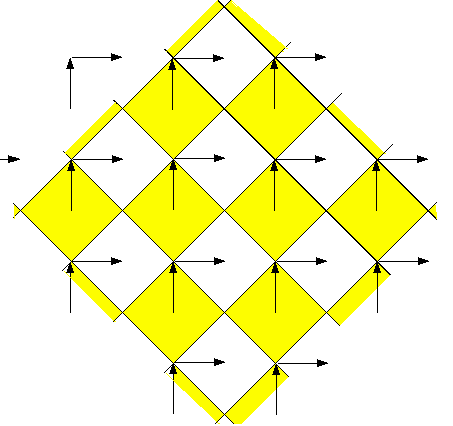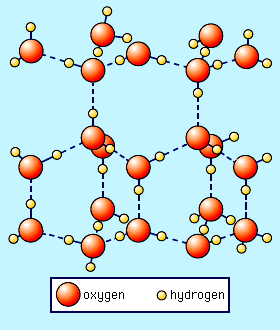
Deriving the Standard Model plus Gravitation
from Simple Operations on Finite Sets
by Tony Smith
Table of Contents:
Chapter 1 - Introduction.
Chapter 2 - From Sets to Clifford Algebras.
MANY-WORLDS QUANTUM THEORY.
Chapter 3 - Octonions and E8 lattices.
Chapter 4 - E8 spacetime and particles.
Chapter 5 - HyperDiamond Lattices.
From E8 to 4HD.
4-dimensional HyperDiamond Lattice.
Chapter 6 - Spacetime and Internal Symmetry Space.
Chapter 7 - Feynman Checkerboards.
Chapter 8 - Charge = Amplitude to Emit Gauge Boson.
Chapter 9 - Mass = Amplitude to Change Direction.
Chapter 10 - Protons, Pions, and Physical Gravitons.
Appendix A - Errata for Earlier Papers.
References.
n-dimensional HyperDiamond structures nHD are constructed from Dn lattices. An n-dimensional HyperDiamond structures nHD is a lattice if and only if n is even. If n is odd, the nHD structure is only a "packing", not a "lattice", because a nearest neighbor link from an origin vertex to a destination vertex cannot be extended in the same direction to get another nearest neighbor link. n-dimensional HyperDiamond structures nHD are constructed from Dn lattices. The lattices of type Dn are n-dimensional Checkerboard lattices, that is, the alternate vertices of a Z^n hypercubic lattice.
Conway and Sloane, in their book Sphere Packings, Lattices, and Groups (3rd edition, Springer, 1999).in chapter 4, section 7.3, pages 119-120) define a packing
[ where the gule vector [1] = (1/2, ... , 1/2) ] and say: "... D+n is a lattice packing if and only if n is even.
D+n is what David Finkelstein and I named a HyperDiamond lattice nHD (although in odd dimensions it is technically only a packing and not a lattice).
Conway and Sloane also say in chapter 4, section 7.1, page 117) that the lattice Dn is defined only for n greater than or equal to 3.
To see what happens for n = 2, note that D2 should correspond to the Lie algebra Spin(4),which is reducible to Spin(3)xSpin(3) = SU(2)xSU(2) = Sp(1)xSp(1) = S3xS3, and is not an irreducible Lie algebra. The root lattice of D2 is two copies of the root lattice of SU(2), which is just a lattice of points uniformly distributed on a line.
If you are to fit the two lines together, you have to specify the angle at which they intersect each other, and requiring "lattice structure" or consistency with complex number multiplication does NOT unambiguously determine that angle: it can be either
60 degrees, which gives you the A2 root lattice
*--* / \ * * \ / *--*
of the Lie algebra SU(3) and the Eisenstein complex integers
90 degrees, which gives you the C2 = B2 root lattice
*--*--* | | * * | | *--*--*
of the Lie algebra Spin(5) = Sp(2) and the Gaussian complex integers.
Since a Dn lattice for n > 3 is a checkerboard, or half of a hypercubic lattice, it is natural to define D2 as a checkerboard, or half of a C2 = B2 square lattice. Then the 2-dimensional HyperDiamond lattice D+2 = D2 u ( [1] + D2 ) is seen to be the Z2 square lattice C2 = B2

where the orginal D2 is made up of the centers of the yellow squares, the glue vectors are the (1/2,1/2) represented by pairs of arrows, and the ( [1] + D2 ) is made up of the centers of the white squares.
The total 2-dim hyperdiamond structure is the Z2 integer lattice, sort of analogous to the 4-dim case in which D4 u ( [1] + D4 ) = Z4, so that
Note that the basic D2 structure is consistent with Feynman's 2-dimensional checkerboard in which the lines of the checkerboard are 2-dim light-cone lines.
Consider the 3-dimensional structure 3HD. Start with D3, the fcc close packing in 3-space. Make a second D3 shifted by the glue vector (0.5, 0.5, 0.5). Then form the union D3 u ([1] + D3). That is the 3-dimensional crystal structure that is made up of tetrahedral bonds:

The above figure (from Encyclopaedia Britannica CD-ROM 98, which got the figure from S.S. Zumdahl, Chemistry, 3rd ed., Heath (1993)) is the crystal structure of H2O Water Ice (whose tetrahedral bonds from Oxygen to Oxygen are each half covalent and half Hydrogen) and of Carbon Diamonds (whose tetrahedral bonds from Carbon to Carbon are purely covalent Carbon-Carbon).
HyperDiamond lattices were so named by David Finkelstein because of the 3-dimensional Diamond crystal structure.
When you construct an 8-dimensional HyperDiamond 8HD lattice,
you get D8 u ([1] + D8) = E8.
The E8 lattice is in a sense fundamentally 4-dimensional,
and
the E8 HyperDiamond lattice naturally reduces to
the 4-dimensional HyperDiamond lattice.
To get from E8 to 4HD, reduce each of the D8 lattices
in the E8 = 8HD = D8 u ([1] + D8) lattice
to D4 lattices.
We then get a 4-dimensional HyperDiamond
4HD = D4 u ([1] + D4) lattice.
To see this,
start with E8 = 8HD = D8 u ([1] + D8).
We can write:
D8 = { ( D4 ,0,0,0,0) u (0,0,0,0, D4 ) }
u
{(1,0,0,0,1,0,0,0) + ( D4 , D4 ) }
The third term is the diagonal term of
an orthogonal decomposition of D8,
and
the first two terms are orthogonal to each other:
associative 4-dimensional Physical Spacetime
and
coassociative 4-dimensional Internal Symmetry space.
Now,
we see that the orthogonal decomposition of
8-dimensional spacetime
into
4-dimensional associative Physical Spacetime
plus
4-dimensional Internal Symmetry space
gives
a decomposition of D8 into D4 + D4.
Since E8 = D8 u ([1] + D8),
and
since [1] = (0.5,0.5,0.5,0.5,0.5,0.5,0.5,0.5)
can be decomposed by
[1] = (0.5,0.5,0.5,0.5,0,0,0,0) + (0,0,0,0,0.5,0.5,0.5,0.5)
we have
E8 = D8 u ([1] + D8})
= (D4,0,0,0,0) + (0,0,0,0,D4))
u
(((0.5,0.5,0.5,0.5,0,0,0,0) + (0,0,0,0,0.5,0.5,0.5,0.5))
+
((D4,0,0,0,0) + (0,0,0,0,D4)))
= ((D4,0,0,0,0) u ((0.5,0.5,0.5,0.5,0,0,0,0) + (D4,0,0,0,0)))
+
((0,0,0,0,D4) u ((0,0,0,0,0.5,0.5,0.5,0.5) + (0,0,0,0,D4)))
Since 4HD is D4 u ([1] + D4),
E8 = 8HD = 4HDa + 4HDca
where 4HDa is
the 4-dimensional associative Physical Spacetime
and
4HDca is
the 4-dimensional coassociative Internal Symmetry space.
The 4-dimensional HyperDiamond lattice HyperDiamond is HyperDiamond = D4 u ([1] + D4). The 4-dimensional HyperDiamond HyperDiamond = D4 \cup ([1] + D4) is the Z^4 hypercubic lattice with null edges. It is the lattice that Michael Gibbs used in his 1994 Georgia Tech Ph.D. thesis advised by David Finkelstein. The 8 nearest neighbors to the origin in the 4-dimensional HyperDiamond HyperDiamond lattice can be written in octonion coordinates as: ( 1 + i + j + k) / 2 ( 1 + i - j - k) / 2 ( 1 - i + j - k) / 2 ( 1 - i - j + k) / 2 (- 1 - i + j + k) / 2 (- 1 + i - j + k) / 2 (- 1 + i + j - k) / 2 (- 1 - i - j - k) / 2 Here is an explicit construction of the 4-dimensional HyperDiamond HyperDiamond lattice nearest neighbors to the origin. Start with 24 vertices of a 24-CELL D4 with squared norm 2: +1 +1 0 0 +1 0 +1 0 +1 0 0 +1 +1 -1 0 0 +1 0 -1 0 +1 0 0 -1 -1 +1 0 0 -1 0 +1 0 -1 0 0 +1 -1 -1 0 0 -1 0 -1 0 -1 0 0 -1 0 +1 +1 0 0 +1 0 +1 0 +1 -1 0 0 +1 0 -1 0 -1 +1 0 0 -1 0 +1 0 -1 -1 0 0 -1 0 -1 0 0 +1 +1 0 0 +1 -1 0 0 -1 +1 0 0 -1 -1 Shift the 24 vertices by the glue vector to get 24 more vertices [1] + D4: +1.5 +1.5 0.5 0.5 +1.5 0.5 +1.5 0.5 +1.5 0.5 0.5 +1.5 +1.5 -0.5 0.5 0.5 +1.5 0.5 -0.5 0.5 +1.5 0.5 0.5 -0.5 -0.5 +1.5 0.5 0.5 -0.5 0.5 +1.5 0.5 -0.5 0.5 0.5 +1.5 -0.5 -0.5 0.5 0.5 -0.5 0.5 -0.5 0.5 -0.5 0.5 0.5 -0.5 0.5 +1.5 +1.5 0.5 0.5 +1.5 0.5 +1.5 0.5 +1.5 -0.5 0.5 0.5 +1.5 0.5 -0.5 0.5 -0.5 +1.5 0.5 0.5 -0.5 0.5 +1.5 0.5 -0.5 -0.5 0.5 0.5 -0.5 0.5 -0.5 0.5 0.5 +1.5 +1.5 0.5 0.5 +1.5 -0.5 0.5 0.5 -0.5 +1.5 0.5 0.5 -0.5 -0.5 Of the 48 vertices of D4 u ([1] + D4), these 6 are nearest neighbors to the origin: -0.5 -0.5 0.5 0.5 -0.5 0.5 -0.5 0.5 -0.5 0.5 0.5 -0.5 0.5 -0.5 -0.5 0.5 0.5 -0.5 0.5 -0.5 0.5 0.5 -0.5 -0.5 Two more nearest neighbors, also of squared norm 1, of the origin 0.5 0.5 0.5 0.5 -0.5 -0.5 -0.5 -0.5 come from adding the glue vector to the origin 0 0 0 0 and to the squared norm 4 point -1 -1 -1 -1 Since the D4-D5-E6-E7-E8 VoDou Physics model is fundamentally a Planck Scale HyperDiamond Lattice Generalized Feynman Checkerboard model, it violates Lorentz Invariance at the Planck Scale, affecting Ultra High Energy Cosmic Rays.
From Sets to Quarks: Table of Contents: Chapter 1 - Introduction. Chapter 2 - From Sets to Clifford Algebras. MANY-WORLDS QUANTUM THEORY. Chapter 3 - Octonions and E8 lattices. Chapter 4 - E8 spacetime and particles. Chapter 5 - HyperDiamond Lattices. Chapter 6 - Spacetime and Internal Symmetry Space. Chapter 7 - Feynman Checkerboards. Chapter 8 - Charge = Amplitude to Emit Gauge Boson. Chapter 9 - Mass = Amplitude to Change Direction. Chapter 10 - Protons, Pions, and Physical Gravitons. Appendix A - Errata for Earlier Papers. References.
Tony Smith's Home Page ......